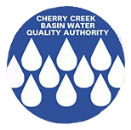Reservoir Model
Cherry Creek Reservoir is a flood control reservoir that has had periodic blue-green algae blooms and high chlorophyll α concentrations.
To increase oxygen at the bottom of the reservoir and reduce the amount of internal nutrient loading, a destratification system was installed in the reservoir in 2008. The system was also intended to help control cyanobacteria in the reservoir by disrupting their buoyancy. However the destratification system has not achieved these goals. Additionally, there has not been enough evidence to show how the destratification system may influence cyanobacteria blooms.
Due to continued water quality concerns, a water quality model of the reservoir was developed to:
- Better understand the causes of chlorophyll α standard exceedances and cyanobacteria blooms;
- Determine the impacts of the destratification system;
- Provide a tool to help predict the effects of future management strategies.
The Authority chose a two-dimensional hydrodynamic and water quality model of the Cherry Creek Reservoir that simulated in-reservoir water quality for 2003-2013.
In 2018, the Authority approved the development of a Bubble Plume Model to occur concurrently with a Destratification System Study, and an update to the Reservoir Model through 2017. This work is currently in process, and will continue into 2019.
The current version of the Cherry Creek Reservoir Water-Quality Model was developed using CE-QUAL-W2, version 3.71. The model accounts for artificial mixing in a simplified manner, in that mixing by the destratification system is simulated as a multiplier on vertical mixing in the depth interval above the diffusers. Bubble plume dynamics are not directly simulated. The Authority is interested in simulating in-reservoir responses due to the effects of destratification by accounting for bubble plume dynamics. A bubble plume model will be used with the CE-QUAL-W2 model to mechanistically simulate the effects of the destratification system on mixing in Cherry Creek Reservoir. This will allow for a more realistic representation of the destratification system in the Cherry Creek Reservoir Water-Quality Model than currently exists, which would then allow the model to be used for evaluating proposed modifications to the existing system and operations.
Useful Links

Question
How would the reservoir respond to the best currently anticipated reduction of nutrients (nitrate, ammonia, and orthophosphate) through watershed controls?
Answer
The reservoir would respond with chlorophyll a concentrations at or below the 18 ug/L summer average standard over the 11-year simulated years (2003-2013). Lower summer cyanobacteria peak concentrations are also predicted.
Question
How much increased vertical mixing is needed for the destratification system to meet the original bottom DO design target of 5 mg/L?
Answer
Model results indicate that a destratification system with three times the vertical mixing effect of the current destratification system would result in at least 5 mg/L of DO at the bottom of the reservoir at nearly all times from 2003 through 2013. Average summer chlorophyll awould decrease in all years, though the value would be above the 18 ug/L standard value in one or the eleven years.
Question
How would the reservoir respond to a combination of the best anticipated watershed controls and destratification mixing that achieves 5mg/L DO at the bottom?
Answer
As would be expected, Run 3 results predict that simulated average summer chlorophyll a concentrations would be lower than those of both Run 1 and Run 2, resulting in summer averages at least 4.8 ug/L below the 18 ug/L standard in all years. Peak summer cyanobacteria concentrations would also be sharply reduced.
Question
What percent reduction in inflow orthophosphate concentration is needed to meet the 18 ug/L Chlorophyll a standard value for all simulated years?
Answer
Modeling indicated that a 75% reduction in inflow orthophosphate concentrations from Cherry Creek was needed to meet the chlorophyll a standard value in all eleven simulated years.
Question
Does the model indicate an adverse effect of increased cyanobacteria in response to a disproportionate reduction of inflow nitrogen relative to orthophosphate in this nitrogen-limited system?
Answer
Based on the model results, further reductions to inflow nitrogen relative to orthophosphate are not expected to have a large effect on summer cyanobacteria, but could increase spring blooms of the nitrogen‐fixing cyanobacteria, Anabaena flos‐aquae.
